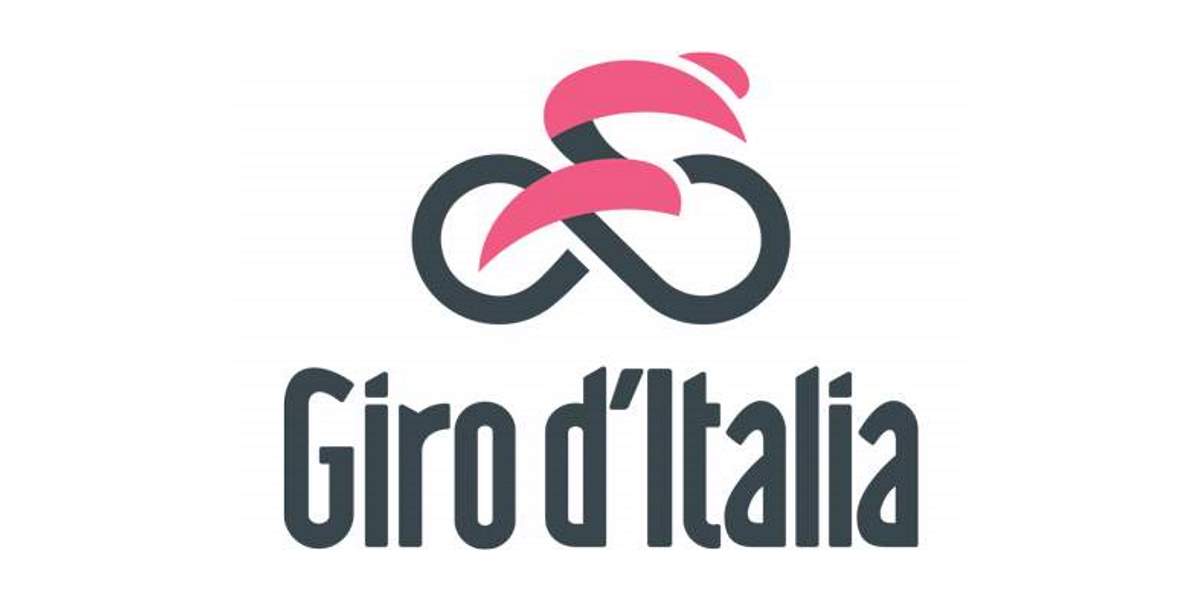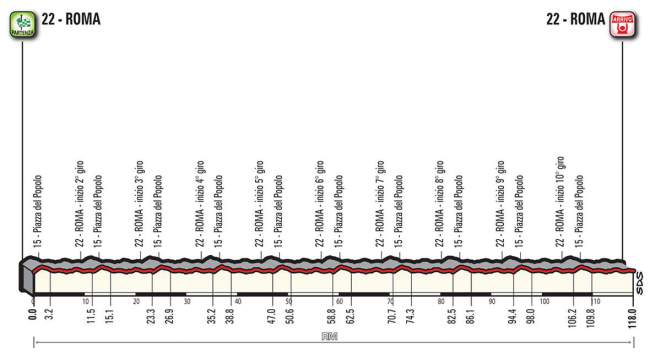Giro d’Italia 2018 route has been announced by RCS Sport, the organizer of the race. For the first time ever, a Grand Tour will start outside of Europe: Israel will host the first three stages of the Giro d’Italia 2018, beginning with an Individual Time Trial in Jerusalem on Friday, May 4. It will also be the 13th time that the Giro starts outside of Italy. The race will be finished in Rome with a final circuit stage on Sunday, May 27. There will be no team time trial (TTT) and limited opportunities for the sprinters in the 101st edition of the Italian grand tour.
In the 101st edition, there will be eight mountaintop finishes of varying difficulty. Four of them will be in the final week. The summit of Monte Zoncolan will be the opener of the 3rd week on stage 14, then will be followed by three consecutive Alpine finishes atop Prato Nevoso, Jafferau, and Cervinia. Stage 19 includes the dirt road fire track climb of the Colle delle Finestre (2,178 m or 7,146 feet), which is the Cima Coppi of Giro d’Italia 2018.
Chris Froome, a four-time winner of the Tour de France was not at the presentation in Milan. But later, he confirmed that he would target the maglia rosa in a video message. Froome last rode the Giro d’Italia in 2009 and 2010.
The last cyclist who rode the Giro after winning the Tour de France was Bradley Wiggins. He won the 2012 Tour and then rode the 2013 Giro (he abandoned the race after stage 12, due to crashes and time losses).
The official promo of the Giro d’Italia 2018
Distinctive Aspects of The Race
Total route: 3.546.2 km
Average length of a stage: 168.9 km
2 individual time trials
7 stages for sprinters
6 medium-difficulty stages
6 high-difficulty stages
8 mountaintop finishes
Giro d’Italia 2018 Stages
Stage 1. Friday, May 4 – Jerusalem / Jerusalem
Type: Individual Time Trial
Length: 9.7 km
A short, very wavy, and complex individual time trial stage. It features a constantly undulating course with changes of direction and no breathing space, given how short it is. Few sections will allow keeping one’s own racing position, and riding skills will be crucial to maintaining the highest speed throughout the stage.
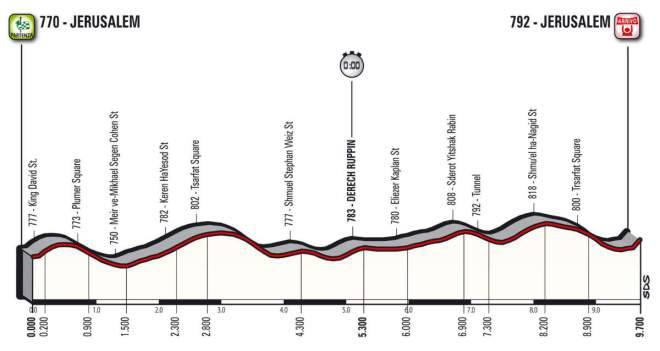
Stage 2. Saturday, May 5 – Haifa / Tel Aviv
Type: Flat
Length: 167 km
Mostly on wide, flat roads with just a few changes of direction, stage 2, a 167 km going from Haifa to Tel Aviv fits the pure sprinters. Half-way through, the only categorized climb in Zikhron Ya’aqov (a town founded in 1882 by Edmond Rothschild in memory of his father James-Yakob) at the top of a very steep short climb, the first gran premio della montagna (King of the Mountains – KOM equivalent of the Giro d’Italia) points will be delivered there. Very fast-running finish section across Tel Aviv and Jaffa.
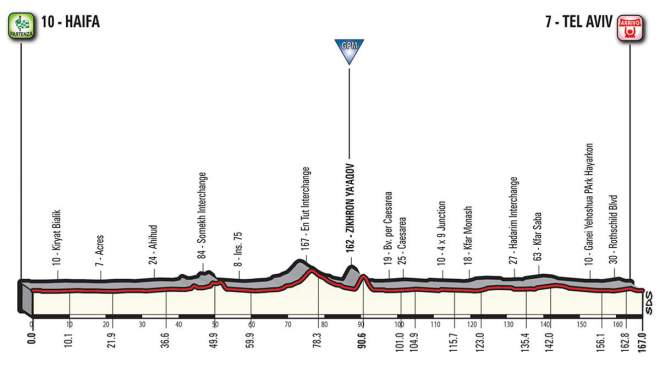
Stage 3. Sunday, May 6 – Be’er Sheva / Eilat
Type: Flat
Length: 229 km
Stage 3 is 229 km going from Be’er Sheva to Eilat. That’s the Negev Desert stage, running by Ben Gurion’s landmarks (the founder of Israel), in particular Sde Boker with his grave. The course runs through Ramon Crater (the largest one in the world, with a 40-km diameter) where the approx. 1200-meter very steep climb is the categorized climb of the day. A field sprint finish in Eilat, a seaside resort on the Red Sea, is to be expected.
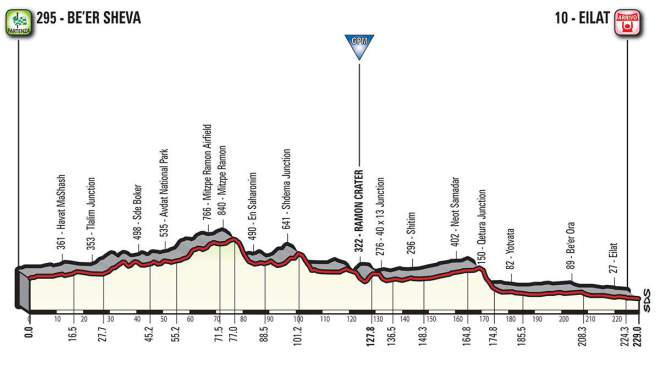
Rest Day 1. Monday, May 7
Stage 4. Tuesday, May 8 – Catania / Caltagirone
Type: Medium Mountain
Length: 191 km
Stage 4 is a medium mountain stage from Catania to Caltagirone, which is 191 km in length. A very windy stage, full of difficulties with undulating stretches in the hills of Southern Sicily. Two categorized climbs, but many more ascents, including the final climb heading for upper Caltagirone. The course runs across the town center skirting famous places such as the stairs Santa Maria del Monte covered with colorful tin-glazed ceramics.
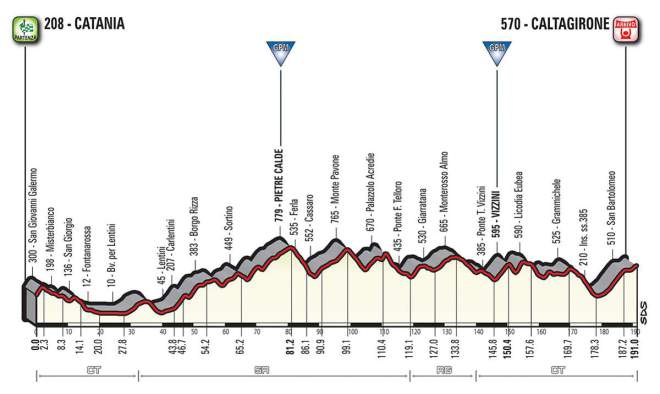
Stage 5. Wednesday, May 9 – Agrigento / Santa Ninfa
Type: Medium Mountain
Length: 152 km
A mixed stage, flat in the first half and wavy in the second half with some uncomplicated ascents. Three categorized climbs in the last 60 km in the “crater” caused by the earthquake in Belice. The first part of the course runs across the Valley of the Temples (km 0) and the Scala dei Turchi up to Selinunte. The final km is uphill, with a very steep climb leading to Santa Ninfa.
Santa Ninfa, Salaparuta, and many other places along the finishing section have been reconstructed following the devastating earthquake in Belice on 14.01.1968 – 6.4 magnitude – with 400 dead.
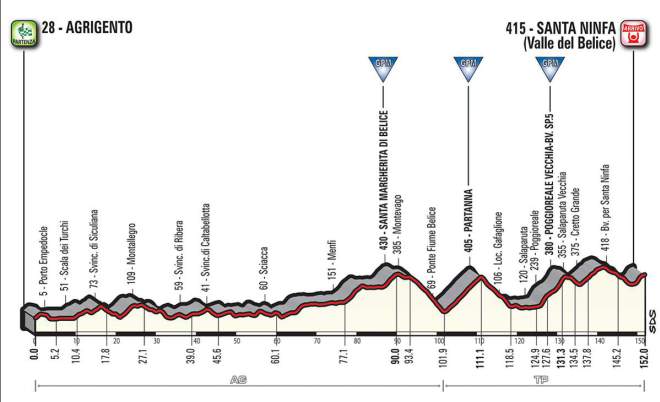
Stage 6. Thursday, May 10 – Caltanissetta / Mount Etna
Type: High Mountain (Summit finish)
Length: 163 km
The first high mountain stage and also the first mountaintop finish of the Giro d’Italia 2018, it is 163 km going from Caltanissetta to the Observatory on Mount Etna, an active stratovolcano on the east coast of Sicily. In the first half, the wavy course running across Enna and Piazza Armerina is an introduction to the final climb: past Paternò a 25-km uphill section with increasing gradient.
Past Ragalna the veritable climb (new) starts on a narrow road winding across parks and lava flows up to the Astrophysics Observatory, located with approx. 3 km to go. The finish line is by the Rifugio Sapienza (finish of several past stages), the mountain Observatory of Catania named after M. G. Fracastoro who directed it in the late 50s.

Stage 7. Friday, May 11 – Pizzo / Praia a Mare
Type: Flat
Length: 159 km

The whole stage running the national road Strada Statale 18. It is suitable for the sprinters in the bunch. The course coasts the Calabria’s Tyrrhenian Sea from Pizzo to Praia. Before reaching the 3-km home stretch on the waterfront, the riders will race across the town.
No categorized climb in this stage, just like the TT and the final stage. Same finish as in 2016, when Diego Ulissi won solo, but this time there won’t be the 18% gradient climb in via del Fortino: from Scalea the course remains on the new SS. 18, avoiding the demanding section of S. Nicola Arcella featured in 2016.
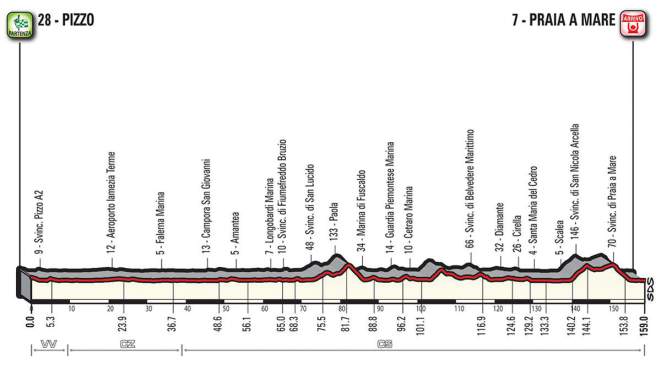
Stage 8. Saturday, May 12 – Praia a Mare / Montevergine di Mercogliano
Type: High Mountain (Summit finish)
Length: 208 km
The second summit finale of this years’ edition. With a length of 208 km, it is a reasonably long stage from Praia a mare to the summit of Montevergine di Mercogliano. After the Lucan coast on the Tyrrhenian Sea, the course runs across the Cilento along its beaches up to Salerno, where the road constantly climbs up to the final ascent leading to the sanctuary. Besides hosting the finish line 5 times in the 2000s, the finish was located here in 1962 (Desmet).
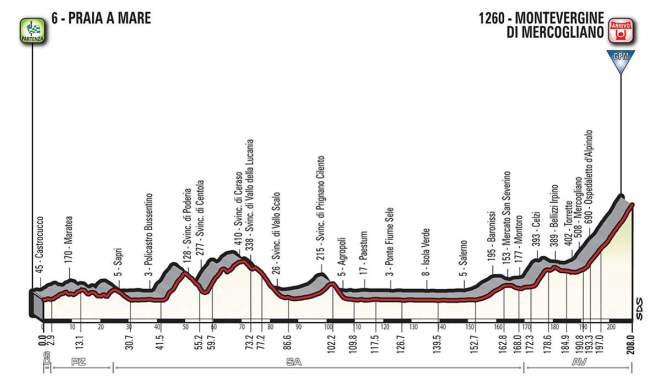
Stage 9. Sunday, May 13 – Pesco Sannita / Gran Sasso d’Italia (Campo Imperatore)
Type: High Mountain (Summit finish)
Length: 224 km

Another long high mountain stage with summit finish from Pesco Sannita to Gran Sasso d’Italia (Campo Imperatore). A very long and wavy stage mostly characterized by the extremely long final climb. As the Montagna Pantani, Gran Sasso (Campo Imperatore) is an endless 45-km climb (new except for the last 6 km) with a flat up halfway through.
It features one categorized climb in Calascio (at approx. 15 km of racing) and another one on the finish line. The third categorized summit is Roccaraso. Just for a few meters difference in height, Campo Imperatore won’t be the Cima Coppi; the Giro 2018 highest peak is Colle delle Finestre. Gran Sasso was a stage finish 4 times, but in 1985 the finish line was located almost 1000 m lower, in Fonte Cerreto.
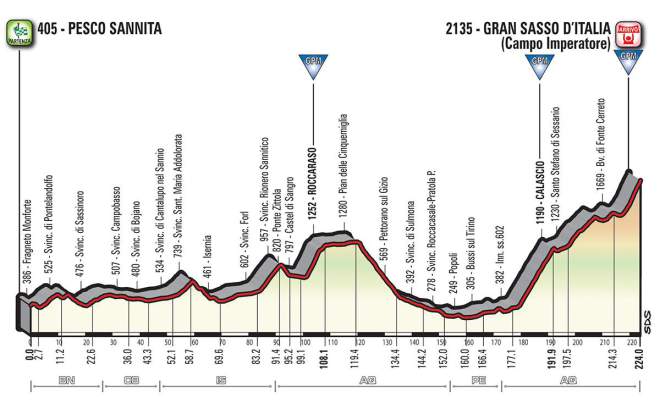
Rest Day 2. Monday, May 14
Stage 10. Tuesday, May 15 – Penne / Gualdo Tadino
Type: Medium Mountain
Length: 239 km
The longest stage of the Giro d’Italia 2018 is a 239 km going from Penne to Gualdo Tadino. From Penne the course runs across the central Apennines, skirting east of the Gran Sasso and the Sibillini Mountains up to Umbria’s Apennine. Countless short climbs, including 3 categorized ones, lead to a wavy finish fit for punchers, though a sprint cannot be ruled out.
A few km after the start, the course runs across Farindola and soon after near what is left of the Hotel Rigopiano (18.01.2017). Past Ascoli Piceno, the race goes across some towns and villages hit by the earthquake in August 2016.

Stage 11. Wednesday, May 16 – Assisi / Osimo
Type: Medium Mountain
Length: 156 km
A wavy stage with medium-long climbs in the first half and the classic Marche’s short steep climbs in the second half. The course runs up to the Passo del Termine (new ascent) and reaches the Province of Ancona with the Muro di Filottrano (Michele Scarponi’s hometown) with gradients reaching 13-14% followed by two short and very steep climbs near Osimo leading up to the finish line in the medieval center of Osimo, which was a finish town already twice (winners: 1987 – Robert Forest and 1994 – Moreno Argentin).
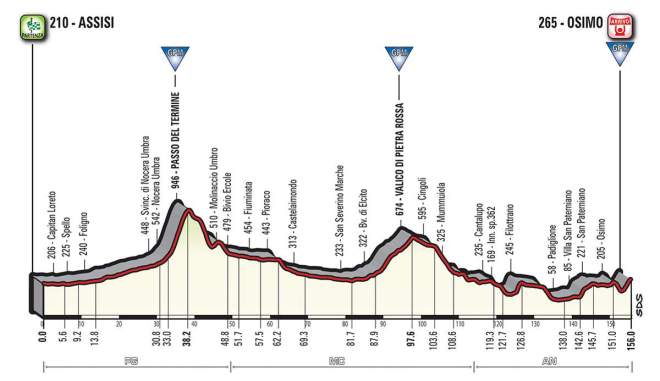
Stage 12. Thursday, May 17 – Osimo / Imola
Type: Flat
Length: 213 km
A completely flat stage first along the SS. 16 “Adriatica” and then the SS. 9 via Emilia in the final part. Only past the finish line, it begins the Tre Monti circuit, to be raced once, which will lead to a likely sprint finish in Enzo and Dino Ferrari Racetrack, where Zakarin won in 2015 and Vittorio Adorni was awarded World champion in 1968.
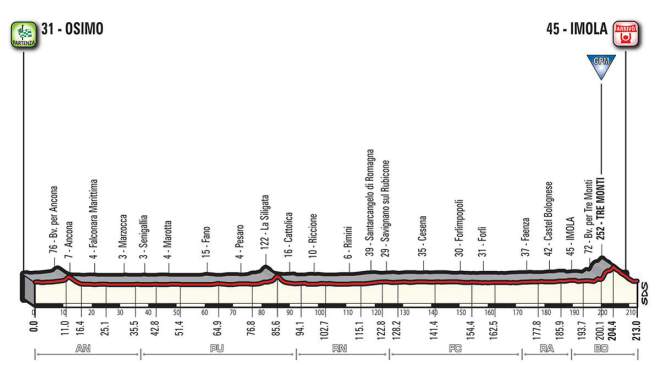
Stage 13. Friday, May 18 – Ferrara / Nervesa della Battaglia
Type: Flat
Length: 180 km
An almost pancake flat stage that crosses the Po Valley from south to north up to Montello with an approx. 30-km circuit with a few climbs that won’t prevent a field sprint. The final section features some iconic WWI landmarks, including the Piave river, and other modern and contemporary wine-related places. Upon approaching the finish, the route runs across the eastern Polesine areas that haven’t been included in a Giro stage for over 30 years.
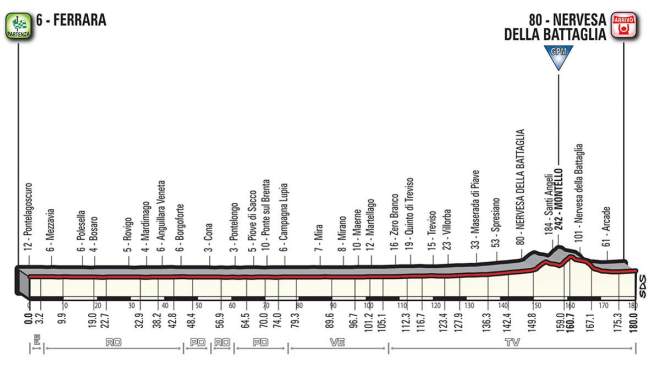
Stage 14. Saturday, May 19 – San Vito al Tagliamento / Monte Zoncolan
Type: High Mountain (Summit finish)
Length: 181 km
First five-star difficulty stage across the Alps. 5 over 181-km long categorized climbs with 4400 m cumulative elevation gain. Monte di Ragogna and its steep climbs and, in the final 45 km, Passo Duron, Sella Valcalda, and Monte Zoncolan, without a single flat stretch, are the summits in this stage. The 6th finish on the Zoncolan, and the 5th one on the “intimidating” side of Ovaro.
On Monte di Ragogna several Tours of Friuli finished, amongst all when Gianni Bugno won the Italian championship in 1990. Monte Zoncolan has gradients topping out 22% in its first part. In Chialina (1.5 km before the foot of the climb) there will be the usual pit-stop where the followers’ vehicles will be replaced by motorbikes.

Stage 15. Sunday, May 20 – Tolmezzo / Sappada
Type: High Mountain (Summit finish)
Length: 176 km
It is a high mountain stage in the Dolomites with 4 categorized climbs, none of which are very hard or too easy. In particular, past Auronzo di Cadore, the stage takes in two new climbs of Comelico (Passo Sant’Antonio and Costalissoio) with gradients almost always above 10%.
The final stretch is slightly uphill. The finish is located a few hundred meters from the finish in 1987, when Stephen Roche claimed the first Maglia Rosa of his “Giro-Tour-World Championships” Grand Slam that year, a feat that only Eddy Merckx managed to make in 1974.
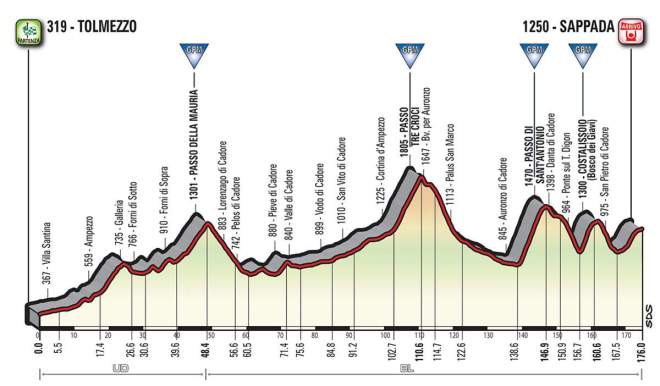
Rest Day 3. Monday, May 21
Stage 16. Tuesday, May 22 – Trento / Rovereto
Type: Individual Time Trial
Length: 34.5 km
An Individual Time Trial which suitable for the specialists. The course is almost completely flat with long straight stretches connected by wide bends where the speed doesn’t drop. The final section in the city is slightly more complex, but still very fast-running. Expected average speed around 50 km/h, and two split time recordings along the course.
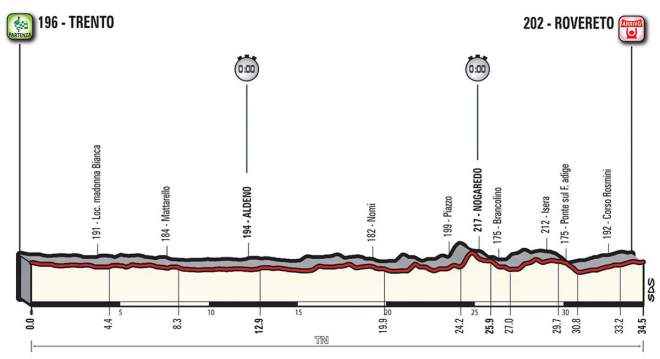
Stage 17. Wednesday, May 23 – Trento / Rovereto
Type: Medium Mountain (Flat finish)
Length: 155 km

Stage with a (slightly) uphill start and a few long tunnels up to Lake Iseo. Short climbs, including the classified Lodrino climb, lead up to the first pass on the finish line. An approx. The 20-km final circuit runs across the entire Franciacorta area. This is the last stage which is fit for sprinters in this year’s race before the final showcase stage in Rome.
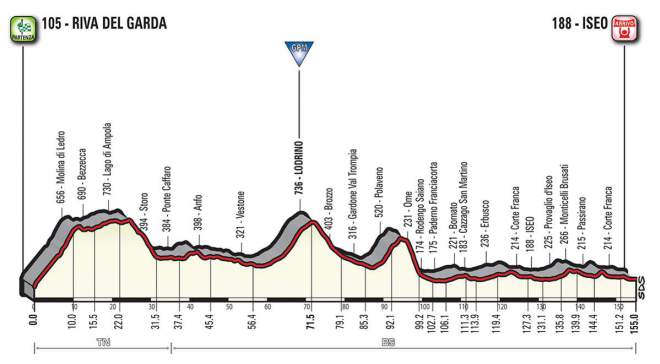
Stage 18. Thursday, May 24 – Abbiategrasso / Prato Nevoso
Type: High Mountain (Summit finish)
Length: 196 km

Almost 200-km flat stage with a final “steep” climb. A very long approach across the Po Valley and the Langhe leads up to Mondovì, where the route starts to climb. Thus, the fight for victory will start here. A long climb with a fairly uncomplicated and very constant gradient leads to the finish. It is the very climb where Pavel Tonkov (1996) and Stefano Garzelli (2000) claimed their win at the Giro and Simon Gerrans (2008) at the Tour.
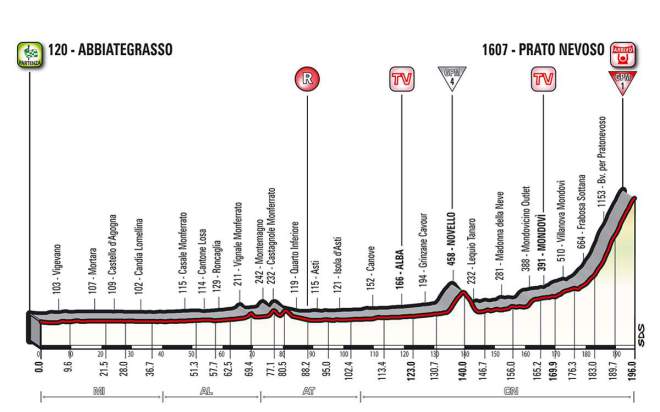
Stage 19. Friday, May 25 – Venaria Reale / Bardonecchia (Jafferau)
Type: High Mountain (Summit finish)
Length: 181 km

A very hard 181 km stage across the Western Alps featuring 4 categorized climbs, all of them being long and testing ascents. Past the Colle del Lys, the stage features the Colle delle Finestre (Cima Coppi) with a 9-km dirt road. This time the finish is not located in Sestrière, which is crossed by the course, but in Bardonecchia (Jafferau), after a 7-km climb at a 9% gradient.
It is the same place where Eddy Merckx joined and passed Josè Manuel Fuente, who had attacked, in 1972. During the “back-up” stage in 2013, that climb was raced without any previous ascent and the finish line was crossed by Mauro Santambrogio (later disqualified) and Vincenzo Nibali, who won the Giro.
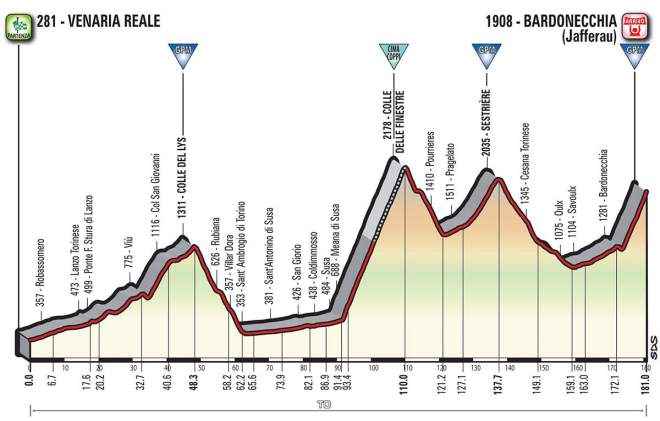
Stage 20. Saturday, May 26 – Susa / Cervinia
Type: High Mountain (Summit finish)
Length: 214 km
The second stage in the Western Alps with 4500-m cumulative elevation gain along 3 climbs only, following a flat (though continuously uphill) section. Once in Valle d’Aosta the race takes in the new 3-km Col Tsecore climb with its last stretch at a gradient over 12% and, after a fast-running descent, the route features St. Pantaléon and Cervinia climbs with no respite.
Col Tsecore has a “changing” name: from the original Col du Mont-Tseuc, in its Italian version, it is called Zuccore as well as Tzecore. The Giro adopts the local signposting denomination that says “Col Tsecore”.

Stage 21. Friday, May 27 – Rome / Rome
Type: Flat
Length: 118 km
Final showcase stage in an 11.8-km circuit to be raced 10 times across the center of Rome. The route runs along most of the roads of the 2009 TT, such as the Fori Imperiali, via Nazionale, via Sistina, Piazza del Popolo, via del Corso, via del Circo Massimo, across the Terme di Caracalla and next to the Colosseum before the finish (possibly a sprint) at the Fori Imperiali.
Sources
- Giro d’Italia Official Website
- Top 18 fastest Paris-Roubaix editions - April 7, 2024
- Col de Tourmalet [Amazing photo from the 1953 Tour de France] - January 11, 2024
- Bernard Hinault and Francesco Moser, 1981 Paris-Roubaix - December 8, 2023
